
IN THIS CHAPTER
Summary: Assess your strengths and weaknesses by answering some sample questions and then reading the answers and explanations, so you’ll know where to focus your efforts when preparing for the exam.

Key Ideas
 Some topics are common to both exams: kinematics, Newton’s laws, work/energy, momentum, circular motion, harmonic motion, gravitation, electrostatics, circuits, magnetic fields and force, and electromagnetism.
Some topics are common to both exams: kinematics, Newton’s laws, work/energy, momentum, circular motion, harmonic motion, gravitation, electrostatics, circuits, magnetic fields and force, and electromagnetism.
 One topic is unique to the Physics C exam: advanced rotational motion.
One topic is unique to the Physics C exam: advanced rotational motion.
 Several topics are unique to the Physics B exam: fluids, thermodynamics, waves, optics, and atomic and nuclear physics.
Several topics are unique to the Physics B exam: fluids, thermodynamics, waves, optics, and atomic and nuclear physics.
 Diagnostic Test
Diagnostic TestTopics Common to Both Exams
Kinematics
1. Which of the following must be true of an object that is slowing down?
(A) Its acceleration must be negative.
(B) Its velocity must be smaller than its acceleration.
(C) It must experience more than one force.
(D) Its acceleration and its velocity must be in opposite directions.
(E) Its velocity must be negative.
2. A baseball is thrown straight up. It reaches a peak height of 15 m, measured from the ground, in a time of 1.7 s. Treating “up” as the positive direction, what is the acceleration of the ball when it reaches its peak height?
(A) 0 m/s2
(B) +8.8 m/s2
(C) -8.8 m/s2
(D) +9.8 m/s2
(E) -9.8 m/s2
Newton’s laws

3. What is the vertical component of F1 in the above diagram?
(A) ½ F1
(B) F1
(C) F1 cos θ
(D) F1 sin θ
(E) F1 tan θ

4. The box pictured above moves at constant speed to the left. Which of the following is correct?
(A) The situation is impossible. Because more forces act right, the block must move to the right.
(B) T3 > T1 + T2
(C) T3 < T1 + T2
(D) T3 = T1 + T2
(E) A relationship among the three tensions cannot be determined from the information given.
The following diagram relates to Questions 5 and 6.
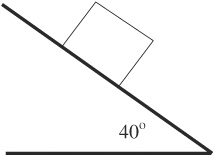
A block of mass m is sliding up a frictionless incline, as shown above. The block’s initial velocity is 3 m/s up the plane.
5. What is the component of the weight parallel to the plane?
(A) mg
(B) mg cos 40°
(C) mg sin 40°
(D) g sin 40°
(E) g cos 40°
6. What is the acceleration of the mass?
(A) 3 m/s2, up the plane
(B) mg sin 40°, up the plane
(C) mg sin 40°, down the plane
(D) g sin 40°, up the plane
(E) g sin 40°, down the plane
7. Which of the following is a scalar?
(A) velocity
(B) acceleration
(C) displacement
(D) kinetic energy
(E) force
8. A 500-g block on a flat tabletop slides 2.0 m to the right. If the coefficient of friction between the block and the table is 0.1, how much work is done on the block by the table?
(A) 0.5 J
(B) 1.0 J
(C) 0 J
(D) 100 J
(E) 50 J
9. A block has 1500 J of potential energy and 700 J of kinetic energy. Ten seconds later, the block has 100 J of potential energy and 900 J of kinetic energy. Friction is the only external force acting on the block. How much work was done on this block by friction?
(A) 600 J
(B) 200 J
(C) 1400 J
(D) 1200 J
(E) 120 J
Momentum
10. Two identical small balls are moving with the same speed toward a brick wall. After colliding with the wall, ball 1 sticks to the wall while ball 2 bounces off the wall, moving with almost the same speed that it had initially. Which ball experiences greater impulse?
(A) ball 1
(B) ball 2
(C) Both experience the same impulse.
(D) The answer cannot be determined unless we know the time of collision.
(E) The answer cannot be determined unless we know the force each ball exerts on the wall.
11. Ball A moves to the right with a speed of 5.0 m/s; Ball B moves to the left with speed 2.0 m/s. Both balls have mass 1.0 kg. What is the total momentum of the system consisting only of balls A and B?
(A) 7.0 N·s to the right
(B) 3.0 N·s to the right
(C) zero
(D) 7.0 N·s to the left
(E) 3.0 N·s to the left
12. Momentum of an isolated system always remains constant. However, in a collision between two balls, a ball’s momentum might change from, say, +1 kg m/s to -1 kg m/s. How can this be correct?
(A) It is not correct. Momentum conservation means that the momentum of an object must remain the same.
(B) A force outside the two-ball system must have acted.
(C) Friction is responsible for the change in momentum.
(D) Although one ball’s momentum changed, the momentum of both balls in total remained the same.
(E) Momentum is conserved because the magnitude of the ball’s momentum remained the same.
Circular motion
13. Which of the following must be true of an object in uniform circular motion?
(A) Its velocity must be constant.
(B) Its acceleration and its velocity must be in opposite directions.
(C) Its acceleration and its velocity must be perpendicular to each other.
(D) It must experience a force away from the center of the circle.
(E) Its acceleration must be negative.
Harmonic motion
14. A mass on a spring has a frequency of 2.5 Hz and an amplitude of 0.05 m. What is the period of the oscillations?
(A) 0.4 s
(B) 0.2 s
(C) 8 s
(D) 20 s
(E) 50 s
15. A mass m oscillates on a horizontal spring of constant k with no damping. The amplitude of the oscillation is A. What is the potential energy of the mass at its maximum displacement?
(A) zero
(B) mgh
(C) kA
(D) ½mv2
(E) ½kA2
Gravitation
16. A satellite orbits the moon far from its surface in a circle of radius r. If a second satellite has a greater speed, yet still needs to maintain a circular orbit around the moon, how should the second satellite orbit?
(A) with a radius r
(B) with a radius greater than r
(C) with a radius less than r
(D) Only an eccentric elliptical orbit can be maintained with a larger speed.
(E) No orbit at all can be maintained with a larger speed.
Electrostatics
17. Which of the following statements about electric potential is correct?
(A) A proton experiences a force from a region of low potential to a region of high potential.
(B) The potential of a negatively charged conductor must be negative.
(C) If the electric field is zero at point P, then the electric potential at P must also be zero.
(D) If the electric potential is zero at point P, then the electric field at P must also be zero.
(E) The electric potential with respect to earth ground can be less than zero at all points on an isolated wire conductor.

18. A uniform electric field points to the right, as shown above. A test charge can be placed at one of three points as shown in the above diagram. At which point does the test charge experience the greatest force?
(A) point A
(B) point B
(C) point C
(D) The charge experiences the greatest force at two of these three points.
(E) The charge experiences the same force at all three points.
19. An electron in an electric field is suspended above the earth’s surface. Which of the following diagrams correctly shows the forces acting on this electron?

20. Which of the following will increase the capacitance of a parallel plate capacitor?
(A) increasing the charge stored on the plates
(B) decreasing the charge stored on the plates
(C) increasing the separation between the plates
(D) decreasing the separation between the plates
(E) decreasing the area of the plates

21. A 10-V battery is connected to two parallel 10-Ω resistors, as shown above. What is the current through and voltage across each resistor?
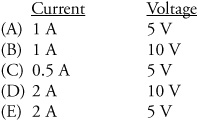
Magnetic fields and force
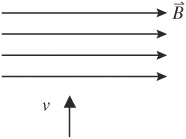
22. A positive point charge enters a uniform right-ward magnetic field with a velocity v, as diagramed above. What is the direction of the magnetic force on the charge?
(A) in the same direction as v
(B) to the right
(C) to the left
(D) out of the page
(E) into the page

23. A long wire carries a current I toward the top of the page. What is the direction of the magnetic field produced by this wire to the left of the wire?
(A) into the page
(B) out of the page
(C) toward the bottom of the page
(D) toward the top of the page
(E) to the right
Electromagnetism
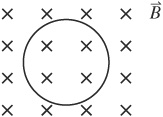
24. A circular loop of wire in the plane of the page is placed in a magnetic field pointing into the page, as shown above. Which of the following will NOT induce a current in the loop?
(A) moving the wire to the right in the plane of the page
(B) increasing the area of the loop
(C) increasing the strength of the magnetic field
(D) rotating the wire about a diameter
(E) turning the magnetic field off
Unique C Topic
Advanced rotational motion
25. A ball of mass m is spinning about a diameter. If it were instead to make twice as many rotations per second, what would happen to the ball’s moment of inertia and its angular momentum?
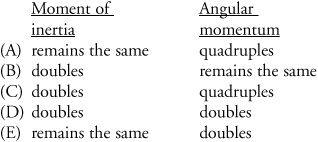
Fluids

26. According to Bernoulli’s principle, for a horizontal, uniform fluid flow in the thin, closed pipe shown above, which of the following statements is valid?
(A) The fluid pressure is greatest at the left end of the pipe.
(B) The fluid pressure is greatest at the right end of the pipe.
(C) The fluid pressure is the same at the left end of the pipe as it is at the right end of the pipe.
(D) At the point in the pipe where the fluid’s speed is lowest, the fluid pressure is greatest.
(E) At the point in the pipe where the fluid’s speed is greatest, the fluid pressure is lowest.
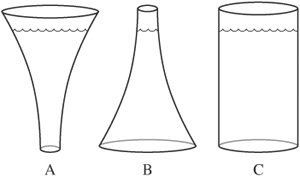
27. The three containers shown above contain the same depth of oil. Which container experiences the greatest pressure at the bottom?
(A) All experience the same pressure at the bottom.
(B) The answer depends on which has the greater maximum diameter.
(C) container A
(D) container B
(E) container C
Thermodynamics
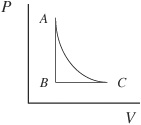
28. An ideal gas is taken through a process ABC as represented in the above PV diagram. Which of the following statements about the net change in the gas’s internal energy is correct?
(A) ΔU = 0 because the process ends on the same isotherm it started on.
(B) ΔU = 0 because no heat was added to the gas.
(C) ΔU < 0 because net work was done on the gas.
(D) ΔU > 0 because net work was done by the gas.
(E) ΔU = 0 because no work was done by the gas.
29. A heat engine is 20% efficient. If the engine does 500 J of work every second, how much heat does the engine exhaust every second?
(A) 2000 J
(B) 2500 J
(C) 100 J
(D) 400 J
(E) 500 J
Waves
30. Which of the following is a possible diagram of standing waves in an organ pipe that is closed at only one end?

31. An earthquake produces both transverse waves and longitudinal waves, both of which travel in a straight line to a seismograph. The waves are detected by the seismograph 500 km away from where the waves were created. Which of the following quantities must be the same for both the transverse and the longitudinal waves?
(A) their wavelength
(B) their amplitude
(C) the distance they traveled to the seismograph
(D) the time they took to travel to the seismograph
(E) their speed
Optics
32. Which of these rays can NOT be drawn for a concave spherical mirror?
(A) a ray through the mirror’s center point reflecting straight back
(B) a ray through the focal point reflecting parallel to the principal axis
(C) a ray parallel to the principal axis reflecting through the focal point
(D) a ray through the mirror’s center point reflecting parallel to the principal axis
(E) a ray to the intersection of the principal axis and the mirror itself, reflecting at an equal angle from the axis
33. The critical angle for the interface between water (n = 1.3) and glass (n = 1.5) is 60 degrees. What does this mean?
(A) Light cannot pass from water to glass unless the angle of incidence is less than 60°.
(B) Light cannot pass from glass to water unless the angle of incidence is less than 60°.
(C) Light cannot pass from water to glass unless the angle of incidence is more than 60°.
(D) Light cannot pass from glass to water unless the angle of incidence is more than 60°.
(E) Light cannot pass from glass to water at all.
Atomic and nuclear physics
34. When a nucleus undergoes alpha decay, its mass
(A) does not change
(B) decreases by 2 amu
(C) decreases by 4 amu
(D) increases by 2 amu
(E) increases by 4 amu
35. An electron in an atom absorbs a 620-nm photon. If the electron started with energy Eo = -3.0 eV, what was the electron’s energy after the absorption?
(A) +2.0 eV
(B) +1.0 eV
(C) -1.0 eV
(D) -2.0 eV
(E) -5.0 eV
END OF DIAGNOSTIC TEST
 Answers and Explanations
Answers and Explanations1. D—Choices A and E don’t make sense because the direction of an object’s acceleration or velocity is essentially arbitrary—when solving a problem, you can usually pick the “positive” direction based on convenience. So neither value must be negative. We can rule out choice B because we know that a fast moving object can slow down very gradually. And there’s no reason why you need multiple forces to make an object slow down, so that gets rid of choice C.
2. E—When an object is thrown in the absence of air resistance near the surface of the Earth, its acceleration in the vertical direction is always g, the acceleration due to gravity, which has a magnitude of 9.8 m/s2. The acceleration due to gravity is directed down, toward the Earth. So the ball’s acceleration is -9.8 m/s2.
3. D—The vertical component of a vector is the magnitude of the vector times the sine of the angle measured to the horizontal; in this case, F1 sinθ.
4. D—Something that moves in a straight line at constant speed is in equilibrium. So, the sum of left forces has to equal the sum of right forces.
5. C—On an incline, the weight vector parallel to the plane goes with the sine of the plane’s angle. g sin 40° is an acceleration, not a weight.
6. E—Because the weight is the only force acting parallel to the plane, mg sin 40° = ma, so a = g sin 40°. This acceleration is down the plane, in the direction of the net force. Yes, the block is moving up the plane, but the block is slowing down, and so the acceleration must be in the opposite direction from the velocity.
7. D—All forms of energy are scalar quantities: potential energy, kinetic energy, work, internal energy of a gas. Energy doesn’t have direction.
8. B—Work is force times parallel displacement. The force acting here is the force of friction, and the displacement is 2.0 m parallel to the force of friction. The friction force is equal to the coefficient of friction (0.10) times the normal force. The normal force in this case is equal to the block’s weight of 5 N (because no other vertical forces act). Combining all these equations, the work done is (2.0 m) (0.1)(5 N) = 1.0 J.
9. D—Look at the total energy of the block, which is equal to the potential energy plus the kinetic energy. Initially, the total energy was 2200 J. At the end, the total energy was 1000 J. What happened to the extra 1200 J? Because friction was the only external force acting, friction must have done 1200 J of work.
10. B—Impulse is equal to the change in an object’s momentum. Ball 1 changes its momentum from something to zero. But ball 2 changes its momentum from something to zero, and then to something in the other direction. That’s a bigger momentum change than if the ball had just stopped. (If we had been asked to find the force on the ball, then we’d need the time of collision, but the impulse can be found without reference to force or time.)
11. B—Momentum is a vector, meaning direction is important. Call the rightward direction positive. Ball A has +5 kg·m/s of momentum; ball B has -2 kg·m/s of momentum. Adding these together, we get a total of +3 kg·m/s. This answer is equivalent to 3 N·s to the right. (The units kg·m/s and N·s are identical.)
12. D—The law of conservation of momentum requires that all objects involved in a collision be taken into account. An object can lose momentum, as long as that momentum is picked up by some other object.
13. C—”Uniform” circular motion means that an object’s speed must be constant. But velocity includes direction, and the direction of travel changes continually. The velocity of the object is always along the circle, but the acceleration is centripetal; i.e., center-seeking. The direction toward the center of the circle is perpendicular to the path of the object everywhere.
14. A—Period is equal to 1/frequency, regardless of the amplitude of harmonic motion.
15. E—The maximum displacement is the amplitude. Energy of a spring is ½ kx2. So, at x = A, the energy is ½ kA2.
16. C—In an orbit, gravity provides a centripetal force. So, GmM/r2 = mv2/r. Solving for v,

where M is the mass of the moon. If the speed gets bigger, then the radius of orbit (in the denominator) must get smaller to compensate.
17. E—Most of these statements drive at the fundamental principle that the value of an electric potential can be set to anything; it is only the difference in electric potential between two points that has a physical usefulness. Usually potential is set to zero either at the ground or, for isolated point charges, a very long distance away from the charges. But potential can, in fact, be set to zero anywhere, meaning that the potential could easily be less than zero everywhere on a wire. (And a proton, a positive charge, is forced from high to low potential; not the other way around.)
18. E—This is a uniform electric field. The force on a charge in an electric field is given by F = qE. Therefore, as long as the electric field is the same at all three points, the force on the charge is the same as well.
19. C—Only forces can go on free-body diagrams, and the electric field is not itself a force. The force provided by an electric field is qE; the weight of the electron is mg.
20. D—Capacitance is a property of the structure of the capacitor. Changing the charge on (or the voltage across) a capacitor does not change the capacitance. The capacitance of a parallel-plate capacitor is given by the equation

Decreasing d, the distance between the plates, will increase the capacitance.
21. B—These resistors are in parallel with the battery; thus, they both must take the voltage of the battery, 10 V. The total current in the circuit is 2.0 A, but that current splits between the two resistors, leaving 1.0 A through each. This can also be determined by a direct application of Ohm’s law— because we know both the voltage and resistance for each resistor, divide V/R to get the current.
22. E—Use the right-hand rule for the force on a charged particle in a magnetic field: point your right hand in the direction of the velocity, curl your fingers toward the magnetic field, and your thumb points into the page. The charge is positive, so your thumb points in the direction of the force.
23. B—This question uses the right-hand rule for the magnetic field produced by a current-carrying wire. Point your thumb in the direction of the current; your fingers wrap around the wire in the direction of the magnetic field. To the wire’s left, your fingers point out of the page.
24. A—Only a changing magnetic flux induces a current. Flux is given by BAcos θ, where B is the magnetic field, and A is the area of the loop of wire. Obviously, then, choices B, C, and E change the flux and induce a current. Choice D produces a flux by changing θ, the angle at which the field penetrates the loop of wire. In choice A, no current is induced because the field doesn’t change and always points straight through the loop.
25. E—An object’s moment of inertia can be thought of as a rotational equivalent of mass; moment of inertia, like mass, is a property of an object and the axis about which it rotates. Moment of inertia does not depend on the speed of rotation. Angular momentum, equal to moment of inertia times angular velocity, does depend on the speed of rotation. Because the rotation rate doubled, so did angular momentum.
26. C—One of the important results of Bernoulli’s equation is that where a fluid flows faster, the fluid’s pressure is lower. But here the fluid is flowing uniformly, so the pressure is the same everywhere.
27. A—The pressure caused by a static column of fluid is P = P0 + ρgh. The shape or width of a container is irrelevant—the pressure at the bottom depends only on the depth of the fluid. All of these fluids have equal depth, and so have equal pressures at the bottom.
28. A—Anytime a thermodynamic process starts and ends on the same isotherm, the change in internal energy is zero. In this case, the process starts and ends at the same point on the diagram, which fulfills the criterion of being on the same isotherm. (Net work was done on the gas because there is area within the cycle on the PV diagram, but that doesn’t tell us anything about the change in internal energy.)
29. A—Efficiency is the useful work output divided by the heat input to an engine. So, in one second, 500 J of useful work was created. At 20% efficiency, this means that every second, 2500 J of heat had to be input to the engine. Any heat not used to do work is exhausted to the environment. Thus, 2000 J are exhausted.
30. D—A wave in a pipe that is closed at one end must have a node at one end and an antinode at the other. Choices A and C have antinodes at both ends; whereas, choices B and E have nodes at both ends.
31. C—Although the material through which waves travel determines the wave speed, longitudinal and transverse waves can have different speeds in the same medium. So the waves can take different times to go 500 km. Nothing stated gives any indication of a wavelength or amplitude (500 km is a distance traveled, not a wavelength), but both waves were produced at the same spot, and have to pass the seismograph; so both waves traveled the same distance.
32. D—Rays through the center point of a spherical mirror always reflect right back through the center point. (Note that the ray described in choice E is a legitimate principal ray, but not one that we discuss in the text nor that is necessary to remember.)
33. B—Total internal reflection can only occur when a light ray tries to travel from high to low index of refraction, so only B or D could be correct. Total internal reflection occurs when the angle of incidence (measured from the normal) is greater than the critical angle.
34. C—An amu is an atomic mass unit, meaning the mass of a proton or neutron. An alpha particle has 2 neutrons and 2 protons, so has 4 amu. When a nucleus undergoes alpha decay, it emits an alpha particle, and so loses 4 amu.
35. C—The energy of a photon is hc/λ. Especially without a calculator, it is necessary to use hc = 1240 eV. nm (this value is on the constant sheet). So, the energy absorbed by this electron is 1,240/620 = 2.0 eV. The electron gained this much energy, so its energy level went from -3.0 eV to -1.0 eV.
Now that you have finished the diagnostic exam and checked your answers, it is time to try to figure out what it all means. First, see if there are any particular areas in which you struggled. For example, were there any questions that caused you to think something such as, “I learned this . . . when?!?” or “What the heck is this?!?” If so, put a little star next to the chapter that contains the material in which this occurred. You may want to spend a bit more time on that chapter during your review for this exam. It is quite possible that you never learned some of the material in this book. Not every class is able to cover all the same information.
In general, try to interpret your performance on this test in a productive manner. If you did well, that’s terrific . . . but don’t get overconfident now. There’s still a lot of material to review before you take the Practice Exams in Step 5—let alone the real AP exam. If you don’t feel good about your performance, now is the time to turn things around. You have a great opportunity here—time to prepare for the real exam, a helpful review book, a sense of what topics you need to work on most—so use it to its fullest. Good luck!